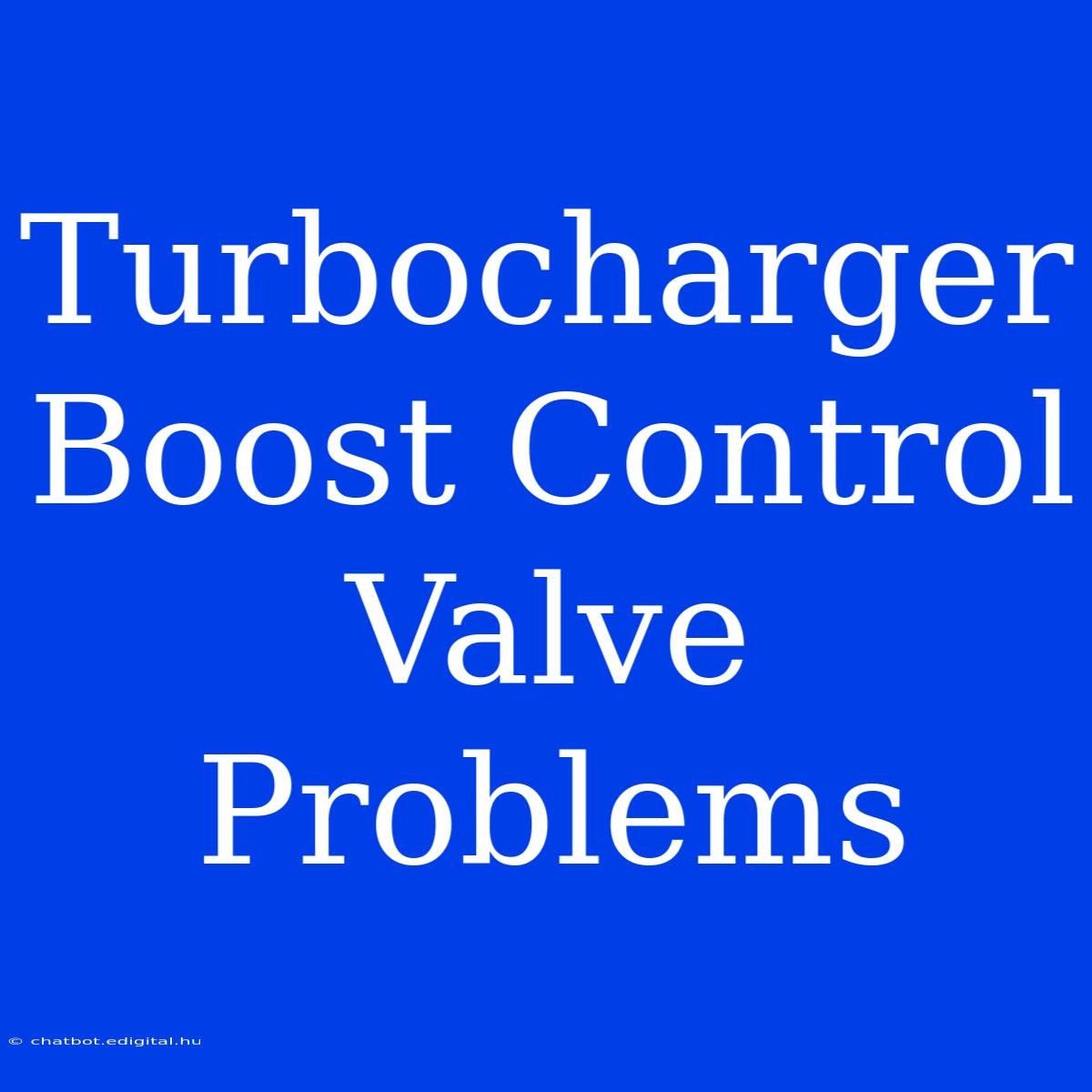Turbocharger Boost Control Valve Problems: Understanding the Symptoms and Solutions
Is your turbocharger struggling to provide the expected power? Turbocharger boost control valve problems can be the culprit, leading to a noticeable decline in your vehicle's performance. Understanding these issues is crucial for maintaining your turbocharged engine's health and ensuring optimal driving experience.
Editor's Note: This article explores the common problems associated with turbocharger boost control valves, providing insights into their role, symptoms, and solutions. Recognizing these issues early can prevent further damage to your engine and save you from costly repairs.
Why is this important? Turbocharger boost control valves play a critical role in regulating the amount of boost pressure generated by the turbocharger, influencing your engine's power output. A malfunctioning valve can lead to erratic performance, reduced fuel efficiency, and even potential engine damage.
Our Analysis: This guide draws upon a comprehensive analysis of common turbocharger boost control valve issues, incorporating insights from industry experts and technical resources. We aim to offer a detailed understanding of the symptoms, causes, and effective solutions to help you diagnose and address these problems.
Key Takeaways:
| Issue | Description |
|---|---|
| Boost Control Valve Malfunction | Failure of the valve to regulate boost pressure, leading to overboost or underboost conditions. |
| Vacuum Leaks | Broken or damaged vacuum hoses connecting the boost control valve to the intake manifold, causing inaccurate boost control. |
| Actuator Problems | Issues with the actuator, which controls the valve's position, leading to sluggish response or inability to regulate boost. |
Let's delve into the essential aspects of turbocharger boost control valve problems:
Turbocharger Boost Control Valve
This section highlights the crucial role of the boost control valve in regulating turbocharger boost pressure. It explores the valve's operation, common failure points, and the consequences of its malfunction.
Key Aspects:
- Function: The boost control valve acts as a gatekeeper, regulating the flow of exhaust gases to the turbocharger, thereby controlling the boost pressure.
- Operation: It typically operates by opening or closing in response to commands from the engine control unit (ECU), based on factors like engine load and speed.
- Failure Modes: Common failures include sticking, leaking, or malfunctioning actuators, leading to inaccurate boost control.
Boost Control Valve Problems: Symptoms and Causes
This section delves into the signs and underlying causes of turbocharger boost control valve problems, enabling early detection and preventative action.
Key Aspects:
- Reduced Power: A sluggish engine and loss of acceleration are common symptoms, indicating a problem with the boost control valve.
- Erratic Boost: Fluctuating boost pressure can cause a surging or lurching sensation, often accompanied by audible whistling or hissing sounds.
- Check Engine Light: A malfunctioning boost control valve can trigger a check engine light, accompanied by a diagnostic trouble code (DTC) indicating the specific issue.
Diagnosing Turbocharger Boost Control Valve Problems
This section outlines the steps involved in diagnosing boost control valve problems, empowering you to troubleshoot and resolve issues effectively.
Key Aspects:
- Visual Inspection: Checking for any visible damage to the valve, vacuum hoses, or actuator is an initial step.
- Boost Pressure Testing: Using a boost gauge to measure the actual boost pressure allows for comparison with factory specifications, identifying deviations indicating a problem.
- Vacuum Line Testing: Ensuring the integrity of vacuum lines by checking for leaks and ensuring proper connection is crucial for accurate boost control.
Solutions for Turbocharger Boost Control Valve Problems
This section explores the repair options for addressing boost control valve problems, providing practical solutions and guidance for a smooth restoration of your vehicle's performance.
Key Aspects:
- Replacement: A faulty boost control valve often requires replacement with a new or refurbished unit, ensuring proper function and reliability.
- Repairing Vacuum Lines: Leaky or damaged vacuum lines should be replaced or repaired to restore accurate boost pressure control.
- Actuator Replacement: A malfunctioning actuator may require replacement to restore smooth and responsive boost control.
FAQ
Q: What are the long-term consequences of neglecting a faulty boost control valve?
A: Neglecting a faulty boost control valve can lead to overboosting, which can damage the turbocharger, intercooler, and other engine components. It can also contribute to excessive wear and tear, affecting fuel efficiency and overall engine longevity.
Q: Can I temporarily fix a leaky vacuum line?
A: While a temporary fix like using tape or clamps might seem tempting, it's not recommended. These solutions are not reliable and can lead to further damage or create safety hazards. Replace damaged vacuum lines with new ones as soon as possible.
Q: How often should I inspect the boost control valve and its components?
A: Regularly inspecting the boost control valve and its components is crucial for preventative maintenance. Visual inspections during routine maintenance checks are recommended, while a more thorough inspection with a boost gauge should be conducted every 10,000 to 15,000 miles or as per your vehicle's service schedule.
Tips for Maintaining your Turbocharger Boost Control Valve
- Regularly check vacuum lines: Inspect for cracks, leaks, or disconnections.
- Clean the boost control valve: Use a compressed air source to remove dirt and debris.
- Avoid harsh chemicals: Don't use harsh cleaning agents or solvents on the valve, as they can damage its delicate components.
- Follow recommended service intervals: Adhere to the manufacturer's recommended service intervals for inspection and maintenance.
Summary
Understanding the symptoms, causes, and solutions for turbocharger boost control valve problems empowers you to maintain optimal engine performance and prevent potential damage. Regular inspections, prompt repairs, and preventive measures contribute to a healthy turbocharged engine, providing reliable power and a fulfilling driving experience.
Closing Message: A malfunctioning boost control valve can significantly impact your vehicle's performance, highlighting the importance of early diagnosis and prompt action. By understanding these issues and taking appropriate preventative measures, you can ensure the longevity and optimal performance of your turbocharged engine.

